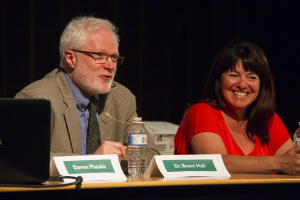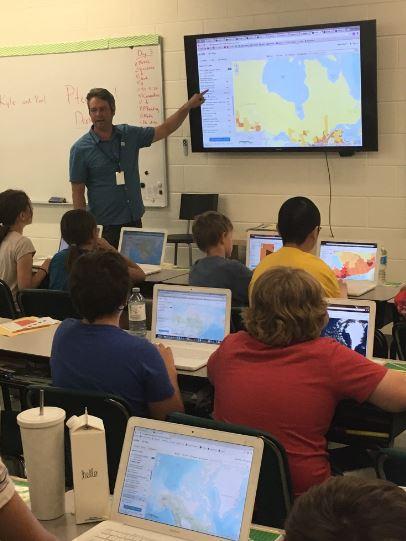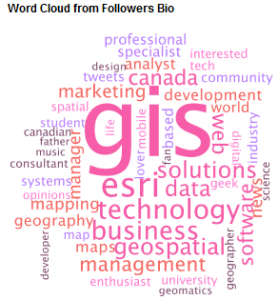
Interview with Brent Hall, Director of Education and Research at Esri Canada and, along with his staff, the initiator of Esri Canada’s GIS Ambassador program.

Dr. Brent Hall is director of Education and Research at Esri Canada. His role is to provide vision and oversight for company activities in k-12 teaching and learning use of Esri software in classrooms across Canada, as well as collaboration with and support for university and college level educators in research and teaching use of Esri software. Esri technology is currently used in close to 20% of Canadian schools at Grades 7-12 and in over 950 k-12 schools in total. This number is increasing rapidly, and will easily exceed 1,000 by the end of 2016 as the company adds provincial and territorial agreements for the use of ArcGIS Online as an approved teaching tool. In higher education, Esri software is used in close to 100% of all comprehensive universities, and in a growing number of colleges. The company is currently supporting and participating in excess of $20m CAD in externally funded higher education research, with a further $12m CAD of projects under review.
GoGeomatics: Hi Brent, welcome and thanks for taking time to talk to the GoGeomatics community. Let’s dive right in and discuss your new program. What is the GIS ambassador program and what are its goals?
Brent Hall: The GIS Ambassador program was introduced by the Education and Research group at Esri Canada in October 2015 as a means to help spread the use of GIS within k-12 instruction across Canada. Its overall goal is consistent with the general goals of improving spatial literacy and the ability of young Canadians to approach and analyze real world problems and seek solutions through the use of GIS-based spatial problem solving. To help realize these goals, the program seeks to recruit volunteers from within the spatial information industry to get involved with k-12 education by delivering a guest lesson to students in a classroom, initiating or participating in a k-12 school-based GIS day event, or assisting with potential career advice and counselling for senior high school students.
GoGeomatics: What types of volunteers are you looking for?
Brent Hall: Ambassador volunteers are drawn specifically from GIS professionals currently working in the spatial information industry; higher education professors, instructors, and students; and employees of Esri Canada Limited. The current and growing number of ambassadors in the program is noted below.
GoGeomatics: How did you come up with the Idea?
Brent Hall: The GIS Ambassador idea has its roots in the need to introduce more spatial thinking and more spatial problem solving using GIS into pan-Canadian k-12 education, combined with a general need to promote the use of GIS in k-12 education. Its immediate genesis was based on the well-established GeoMentor concept and program initiated in the United States by the Association of American Geographers (AAG) to promote the teaching of geography in American k-12 schools. The AAG’s GeoMentor program was recently fused with Esri Inc’s ConnectED strategy, which seeks to achieve the mainstream adoption of ArcGIS Online at 25,000 US k-12 schools, with a goal of providing software access to one million school users, by December 31, 2017.
GoGeomatics: What were your intentions with the program and Why did you choose the term “GIS Ambassador?”
Brent Hall: Our intention for the Canadian GIS Ambassador program is to cater specifically to the curricula and needs of Canadian k-12 schools and students. The term ‘GIS Ambassador’ was chosen deliberately to emphasize GIS over ‘Geo’, and to promote GIS technology use for spatial problem solving in education. This does not relegate the ‘geo’ prefix. Rather, it promotes the view that a sound understanding of ‘geo’, i.e. geography and the promotion of spatial thinking, is intertwined with in the use of GIS technology to achieve these educational outcomes. Hence, simply stated, the GIS Ambassador program seeks to promote the use of GIS to achieve sound geographic or spatial thinking and problem solving among Canadian k-12 students.
Use of GIS technology is relevant to many more subjects than traditional geography, and promoting spatial literacy and thinking through the use of GIS in subjects such as history, science, civics, social studies, environmentalism, globalism and many others is centrally important to producing well-rounded and technologically adept young Canadians. The term ‘ambassador’, rather than mentor, was chosen to represent this community as it defines a well understood role in society for someone who represents or promotes a specified activity (e.g. Roger Tomlinson was widely recognized as ‘the Father of GIS’ and was also a great ambassador for the promotion of geography and spatial thinking).
GoGeomatics: What types of connections are Ambassadors likely to have in the community?
Brent Hall: GIS Ambassadors are each likely to have personal connections with the Canadian k-12 school system. These connections may include the school(s) that they attended themselves earlier in life, or that their children attended, or currently attend. Hence, the program seeks to foster the rebuilding of old, strengthening of current, and creation of new connections between members of the spatial information industry and Canadian k-12 educators and students. These connections foster collaboration and community building.
GoGeomatics: What are the activities that Ambassadors take part in as part of the program?
Ambassador activities may include using one or more of the many Canadian curriculum-focused k-12 lesson packs produced by Education and Research group staff at Esri Canada, and available on-line for educators to use in the classroom. These resources allow a volunteer to show the students hands-on how ArcGIS Online can be used in fun and interesting ways to examine important issues. Activities may also involve helping students to build their first story map with their named user account in ArcGIS Online. In other cases, where Ambassadors are less comfortable with leading a class or using the technology, they could help to organize a GIS day event at their childrens’ school, or return to their former school to help run a similar event. In yet other contexts an Ambassador may simply supply data, hard copy maps or textbooks to a school for use in some aspect of the curriculum. In extreme cases, an Ambassador might plan and help a teacher run a field excursion using the Collector App with students in an environmental science or physical geography class to record data on water, soil and vegetation samples along a stream for subsequent lab testing and mapping in ArcGIS online.
GoGeomatics: Beyond those activities what other possibilities are there?
There are many activities beyond those noted that an Ambassador can participate in to help promote the use of GIS technology in Canadian schools. The scope is limited really only by the imagination of the individual and his/her willingness to give back to the education system that they passed through earlier in life. The need for these activities and their importance is self-evident. In many jurisdictions in Canada K-12 curricula are designed by educators working alongside Ministerial or Departmental bureaucrats, the far majority of whom have never heard of GIS and are unlikely perhaps even to be aware of the concepts of spatial literacy and spatial problem solving in education. Indeed, in many provinces the move to STEM-oriented curricula, and the view of geography as a soft-science or even a non-science, that can be adequately taught and understood through Social Studies or other subjects, has seen a diminished presence, or even removal, of explicit ‘geo’ or spatial content in curricula. Hence, it is essential that every effort be made to strengthen where it is diminished, or to re-establish where it is removed, spatial content across multiple subject areas. The role of GIS Ambassadors is essential in this context.
GoGeomatics: How many GIS Ambassadors are out there today?
Brent Hall: As of July 13 there were 149 GIS Ambassadors across Canada. The community comprises higher education students (24), GIS professionals (72), educators (25), and Esri Canada employees (28). Since May of this year, 30 new GIS Ambassadors have joined the program, and with a press on membership in the community this fall we expect the number to increase to over 250 by year end. Most of the ambassadors are active during the school year, and plans are in place for engagements after schools start in September. For example, of the 90 Ambassadors in Ontario (comprising 13 higher education profs/instructors; 21 higher education students, 37 GIS professionals and 19 Esri Canada staff), 67 want to connect with a school to present a GIS day event or connect with a teacher, 23 have been connected to work with a teacher or school in the fall, 15 will be presenting a class to schools not currently using GIS, and 10 will be presenting at schools already known to be users of ArcGIS Online. This level of granularity of activity is managed and tracked by Education and Research staff in conjunction with the Ambassador community, and is explained further below.
GoGeomatics: Will the GIS ambassador program evolve? What is in store for the future?
Brent Hall: It is our expectation and hope that the program will evolve and grow considerably from its grassroots origins as word spreads of its existence. This fall we will be undertaking a stepped up recruitment drive for new Ambassadors as we add new licensing agreements for ArcGIS Online use in k-12 education across the country. For example, in July 2016, the Province of British Columbia became licensed for all private and public k-12 schools under the auspices of the province’s Education Resource Acquisition Consortium (ERAC) – http://news.bcerac.ca/arcgis-at-no-charge-for-use-by-erac-members/. In Western Canada, the Yukon Territory was similarly recently licensed, and discussions are underway with other Provinces and Territories across the country for k-12 ArcGIS Online licensing.
GoGeomatics: If someone wants to become an Ambassador how do they join?
Brent Hall: Joining the Esri Canada GIS Ambassador community is simple. For those passionate about the use of maps and map data and interested in giving back some of their knowledge and experience by connecting with k-12 educators and students, all that is required initially is to visit http://www.esri.ca/en/content/gis-ambassador-program and click the Get Started button.
Before you do this you can pause to read a blog post about Larisa Johnstone, one of the current ambassadors, or visit the Education and Research blog at http://esri.ca/en/blog/zoe-goodyear-gis-ambassador to read about Zoe Goodyear, another member of the current ambassador community. Complete the form on the Register to Become a GIS Ambassador page and a member of the Education and Research staff will be in contact soon thereafter.
GoGeomatics: What type of support to the Ambassadors receive?
Brent Hall: Every Ambassador receives an ambassador’s kit, which includes a branded backpack (see accompanying photo) and a portfolio folder that contains an ambassador button, a sample 6×6 (six activities that take 6 minutes each with ArcGIS Online) lesson to use with students in the classroom, and a series of ambassador profiles as well as cards to leave at the school or to provide to other potential community members. Also present in the kit is a hard copy map with a list of six schools within easy access of the ambassador’s place of work or residence, with the schools current status of ArcGIS Online use in at least one class (licensed and a current user, licensed but not currently using the software, not yet licensed) identified. This information is also available in a Web app that is made accessible to all ambassadors.
GoGeomatics: Thanks again for taking the time to discuss the GIS Ambassador program with the GoGeomatics Canada community. Brent we look forward to hearing more from you and all the Ambassadors across Canada.




Be the first to comment